The Enlightened Truth about Christmas
 Today is St. Lucia’s Day, the first of the 12 Days of Light honoring the Star of Bethlehem. Tonight we light up the decorations!
Today is St. Lucia’s Day, the first of the 12 Days of Light honoring the Star of Bethlehem. Tonight we light up the decorations!
But, today is also a good time to reflect on the importance of Christmas.
 Today is St. Lucia’s Day, the first of the 12 Days of Light honoring the Star of Bethlehem. Tonight we light up the decorations!
Today is St. Lucia’s Day, the first of the 12 Days of Light honoring the Star of Bethlehem. Tonight we light up the decorations!
But, today is also a good time to reflect on the importance of Christmas.
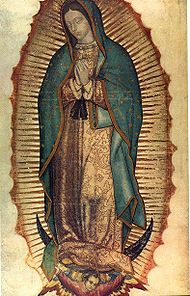 The AUR liturgical year opens with a series of holidays emphasizing the multi-cultural, multi-faith scope of American Reform Unitarian Christianity.
The AUR liturgical year opens with a series of holidays emphasizing the multi-cultural, multi-faith scope of American Reform Unitarian Christianity.
All Corners Day on November 12 honors “Pious Outsiders” from other nations and faiths. The Thanksgiving season is famously devoted to peaceful cooperation between different ethnic and religious communities. And, these holidays culminate on January 6 with Epiphany — the epitome of Christian syncretism — which commemorates the adoration of infant Jesus by the Magi, who were foreigners to Judea and members of a non-Abrahamic religion.
December 12, which is the last of the 12 Days of Gold commemorating Mary’s motherhood, is also in the tradition of inter-faith community. On this day, in conjunction with Roman Catholics we honor the Our Lady of Guadalupe, who is believed by many scholars to be an exaptation of Aztec devotion to Tonantzin, meaning “Our Mother,” a title bestowed upon various divine female figures, similar to the Hindu term Devi.
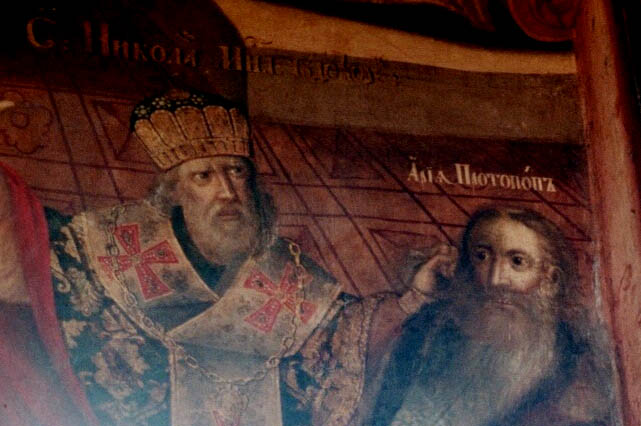
Nicholas of Myra punching Bishop Arius at the Council of Nicaea
The birth of Jesus Christ may be the “reason for the season,” but for millions of children the man of the moment is Santa Claus.
While it is widely known that the Santa Claus of Christmas is derived from St. Nicholas, few know much about the original Saint Nick beyond the fact that he did not live at the North Pole, own flying reindeer, or employ a workshop full of elves.
Nicholas was a political ally of Athanasius of Alexandria during the Church intrigues of the 4th Century that led to Trinitarianism. And, like Athanasius, he is rumored to have come into power at an absurdly young age through dubious means.
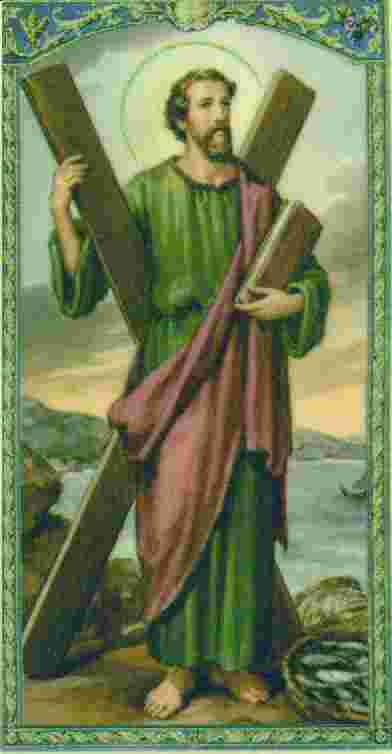 Andrew is not the most well-known Apostle.
Andrew is not the most well-known Apostle.
However, he was the first disciple of Jesus Christ. He was also the brother of Simon who later became St. Peter, the Rock of the Church. In fact, it was Andrew who introduced Simon to Jesus.
Andrew was also a fisherman (as was Simon Peter) and it was through interaction with him that Jesus first became associated with the fish, one of the earliest symbols of Christianity.
It is fitting, then, that the Feast of St. Andrew also be the Eve of Advent, in anticipation of the first idiomatically Christian season of the AUR calendar, Christmas!
On St. Andrew’s Day, let’s look forward to the Season. (And, do something nice for your siblings!)
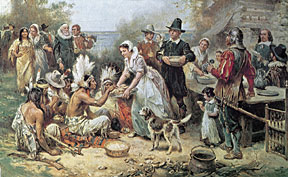 Thanksgiving is often recognized as an inter-cultural holiday, celebrating the cooperation of European Pilgrims and Native Americans, but it is also an interfaith holiday. After all the Wampanoag were not Christian.
Thanksgiving is often recognized as an inter-cultural holiday, celebrating the cooperation of European Pilgrims and Native Americans, but it is also an interfaith holiday. After all the Wampanoag were not Christian.
For American Reform Unitarians* the interfaith nature of Thanksgiving actually reinforces its Christian importance, for we see Christianity not as a religion defined against others, but as an idiom of Truth that can be translated into other idioms.
[This Thanksgiving message was originally published in 2008]
True Christianity has from its inception been a religion that sees the good in members of other religions.
Jesus praised the faith of the pagan centurion over that of his fellow Jews, and used a member of the hated Samaritan sect (considered heretics at the time) as a symbol of goodness in explicit contrast to leaders of his own faith community. When ministering to the Greeks, the Apostle Paul even went so far as to claim that the “Unknown God” long worshiped in Hellenistic religion was in fact the very same God of Abraham and Jesus.
Some might dismiss Paul’s assertion as a marketing technique, and perhaps so. However, the willingness to seek Christian truth in other religions validates Christianity as a religion about reality rather than a religion merely about itself.
There is, in every religious community, a moral tension between loyalism and realism. By realism here, we do not mean the “Christian Realism” of Niebuhr, but realism in the sense that religion is seen as an idiomatic description of reality, therefore open to other forms of description.
This is opposed to the loyalist approach in which that description becomes a mere catechetical shibboleth, a catch-phrase or password, distorting the religion into an entrenched camp isolated (by its own members) from the rest of the universe.
A religion truly about the Creator cannot be an enclave in Creation. The truth of God does not need to be spread across God’s own work by a tiny minority of creatures; God’s truth is evident throughout the universe.
Justin Martyr, despite his sainted status, is likely the primary culprit in this God-denying loyalist tradition as he was the first to attribute other religions entirely to the action of devils. One step more “realistic” is the approach of Paul and other missionaries who attempted to exapt the language and imagery of the cultures they encountered for Christian truth.
But, while this approach treats idiom properly as a tool rather than the stuff of religion itself, it is still prone to error due to the implication that only the language of other religions is valid, not the underlying reality that language describes.
Again, this sort of religion implies an agoraphobic god who fashions a vast universe only to cower in one tiny corner of it, charging mere humans with braving the immeasurable remainder of it in his stead. Religion that genuinely worships the Almighty Creator does not insult God in this way.
The idiomatic approach of Reform Unitarianism takes realism to its full measure by recognizing that some of the underlying ideas of other religions must be valid if the God we worship is indeed the God of all Creation, and not merely an imagined god of ethnic or sectarian autolatry.
For us, the Thanksgiving story represents two groups of God’s children, speaking in different idioms, coming together for a precious moment of peace and communion. The words and labels each used to discuss the ultimate nature of reality and its moral implications may have differed, but if there is such an Ultimate Truth then it must be the same Ultimate Truth for all, despite the difference in languages used to describe it.
The politicized, sectarian, God-denying, and autolatrous view is that the Native Americans were un-Christian heathens. The truly Christian, universal, Creator-affirming, moral view is that while the compassion the Wampanoag showed the Pilgrims may not have been “Christian” charity, it was certainly Christian charity.
Have a wonderful feast day, and give thanks for all of the blessings in your life!
_
* American Reform Unitarians revere Thanksgiving’s Harvest Thursday as one of the Four Great Thursdays alongside Declaration Thursday, Garden Thursday, and Ascension Thursday.
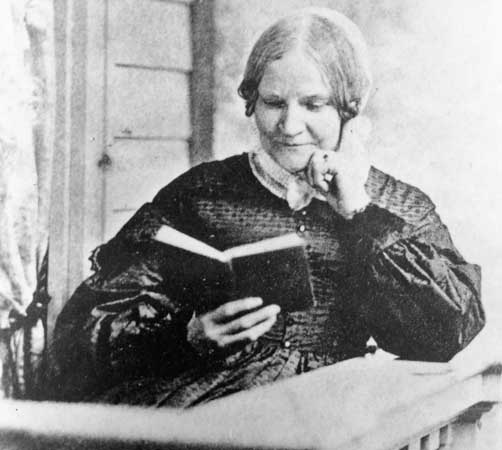 Many readers may recall the line “over the river and through the wood” as part of a song called A Merry Christmas at Grandmother’s, but the song was originally a Thanksgiving tune, with the ultimate destination Grandfather’s house.
Many readers may recall the line “over the river and through the wood” as part of a song called A Merry Christmas at Grandmother’s, but the song was originally a Thanksgiving tune, with the ultimate destination Grandfather’s house.
And, the song was originally a poem called “A Boy’s Thanksgiving Day” written in the 1840s by Lydia Maria Child, a remarkable Unitarian who advocated for women’s rights and the rights of Native Americans. A novelist ahead of her time, she also followed the track of abolitionism in the 19th Century, first advocating a pacifist approach yet later accepting the unfortunate need for violence to effect the liberation of African-American slaves.
As we celebrate the 12 Days of Thanksgiving, it is important to honor the author who wrote the most well-known Thanksgiving lyrics, and who exemplified the Reform Unitarian approach to this season, open to the joy and practical virtue of meetings between cultures, while still keeping eyes open to the tragic consequences that often attend to those meetings.
May God bless the memory of Lydia Maria Child.
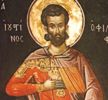 In honor of St. Justin, today we re-post a selection of quotes from his writings, originally posted in 2008.
In honor of St. Justin, today we re-post a selection of quotes from his writings, originally posted in 2008.
Justin is important not only because his feast day begins the 12 Days of Unity, the “Bud Dozenal” of the Spring Rose Season, but because Justin is the earliest writer explaining and defending the theology of Christianity as if to an outsider.
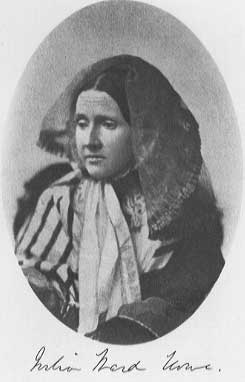 This year’s Ultimate Thursday of the 12 Days of Thorns falls on the birthday of Julia Ward Howe, a Unitarian best known for writing the lyrics to The Battle Hymn of the Republic, a march calling the righteous abolitionist to war.
This year’s Ultimate Thursday of the 12 Days of Thorns falls on the birthday of Julia Ward Howe, a Unitarian best known for writing the lyrics to The Battle Hymn of the Republic, a march calling the righteous abolitionist to war.
And, the spirit of militant abolitionism — which finally crushed the slave economy after decades of impotent pacifist abolitionism satisfied its own sentimentality while the slaves suffered in bondage — is perfectly congruous with the lesson of this dozenal. There can be no moral success, no advance of justice, without trial and tribulation.
Those seeking the easy way out of injustice will usually instead find no way out.
Unfortunately, after the War of Liberation, Ms. Howe reverted to the pacifism that had for so long shackled abolitionism, and kept generations of African Americans shackled along with it. Even so, the words of her Hymn still ring true for those who seek justice, truth, and freedom with open eyes. Continue reading
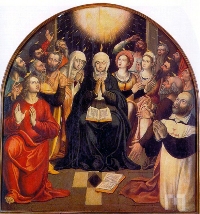 On the second Sunday following Ascension Thursday falls the Pentecost, originally a Hebrew harvest festival known as Shavuot (חג השבועות, “Festival of Weeks”) or the Day of First Fruits. It is also called White Sunday in some Northern European countries.
On the second Sunday following Ascension Thursday falls the Pentecost, originally a Hebrew harvest festival known as Shavuot (חג השבועות, “Festival of Weeks”) or the Day of First Fruits. It is also called White Sunday in some Northern European countries.
As often happens, this year the Pentecost dozenal falls inside Rose Season. But even though Unitarian Reform is more focused on the 12 Days of Thorns this year, Pentecost is still an important holiday, the afterword of the Lent-Ascension cycle.
Meaning of the Season. In Judaism, this day commemorates the descent of the Law on Mt. Sinai, but in Christianity it commemorates the descent of the Holy Spirit on followers of Jesus. Taken together, these two express the complementary virtues that are the underlying theme of Abrahamic spirituality — Faith and Hope, Law and Wisdom, Son and Spirit, Lion and Lamb, Serpent and Dove, the Two Trees of Knowledge and Life — the same complementary virtues displayed on Ascension Thursday.
In both cases, a great flowering resulted. Just as the Jewish people were bound by the physical ties of tribe and family, Christians are bound by the mental ties of concept and idiom. So, in Jewish tradition, Mt. Sinai became covered in blooms and greenery after the Law was revealed, a material flowering. In Christian tradition, the descent of the Spirit resulted in the crowds in Jerusalem being able to understand the Gospel in their own languages, a mental flowering.
For Reform Unitarianism, these parallel revelations on Shavuot/Pentecost represent a great reconciliation of complementary goods: punitive Law which outlines strict rules of conduct to protect us from the perils of the material world, and benevolent Wisdom which over-rules the obstacles of language to protect us from the perils of ideology and cultural/linguistic isolation.
[An earlier version was published on previous Pentecost Sundays]
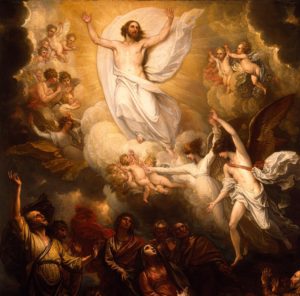 The Twelve Days of Commission conclude today in the Ascension of Jesus. This feast day is one of the Four Great Thursdays of AUR, the other three being Garden Thursday, Declaration Thursday, and Harvest Thursday.
The Twelve Days of Commission conclude today in the Ascension of Jesus. This feast day is one of the Four Great Thursdays of AUR, the other three being Garden Thursday, Declaration Thursday, and Harvest Thursday.
Ascension commemorates the return of Jesus to Heaven between two angels. This imagery places a final seal on the importance of reconciled, complementary virtues to Christian morality by closing Jesus’ time on Earth with symbolism that echoes a consistent theme throughout religion, both Christian and otherwise.
For example, in the book of Numbers, we read that the Word of God came to the Jews from between the two angels on the “Reconciler,” a device which sat atop the Ark of the Covenant.
Medieval Jewish theologian Moses Maimonides explained that these two angels on the Ark represented the punitive and beneficent aspects of God, reconciled in God’s Unity.
This moral message of reconciled virtues can also be seen symbolically in the prophecy of Isaiah that the Anointed returns when the wolf and the lamb, the leopard and the kid, and the lion and the calf lie down together.
In the Christian idiom are repeated lessons in reconciled, complementary virtues: Law and Wisdom reconciled in true religion, Faith and Hope reconciled in Divine Love, the shrewdness of serpents and the innocence of doves reconciled in the attitude of a true Christian.
Justice and mercy, strength and kindness, the arrow and the olive branch: these are the yin and yang of the Abrahamic idiom. Only together and reconciled are these virtues; apart and partisan, they become the vices of Beast and Babylon, rage and lust, violence and libertinism, authoritarianism and anarchy.
The Reconciling Word of God, manifest in Jesus of Nazareth, returned to Heaven between two angels representing the benevolent and punitive aspects of God, angels who appeared beside him echoing the cherubim of the Ark. It is this image, and its rich spiritual meaning, that we commemorate on Ascension Thursday.
[A version of this homily was published on a previous Ascension Thursday.]